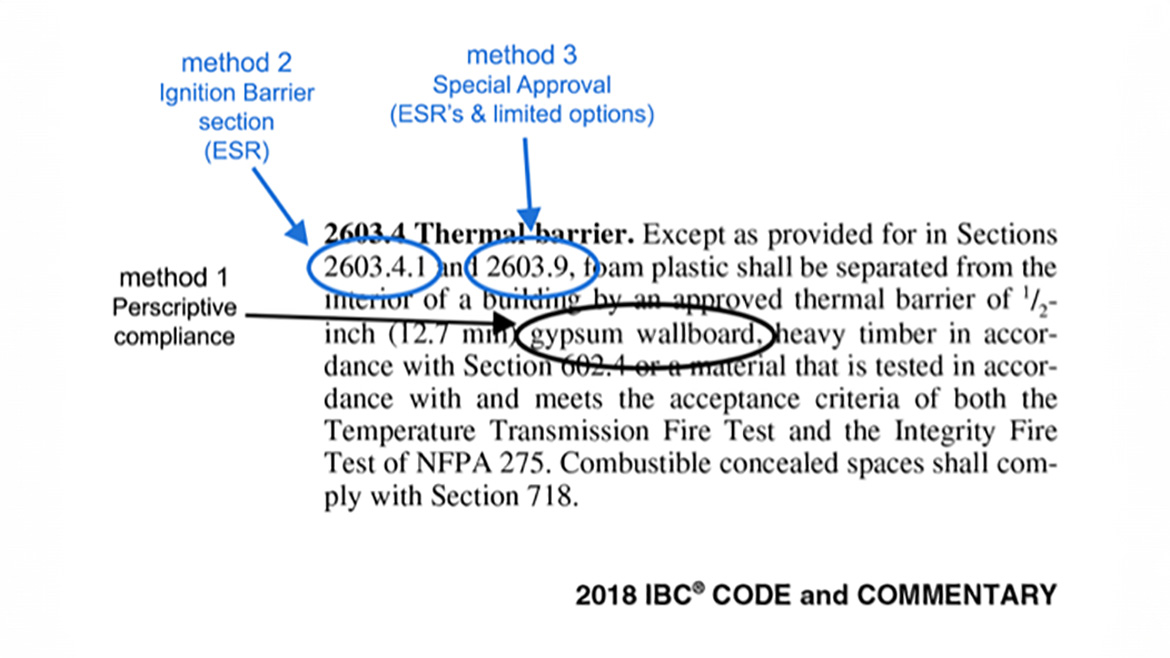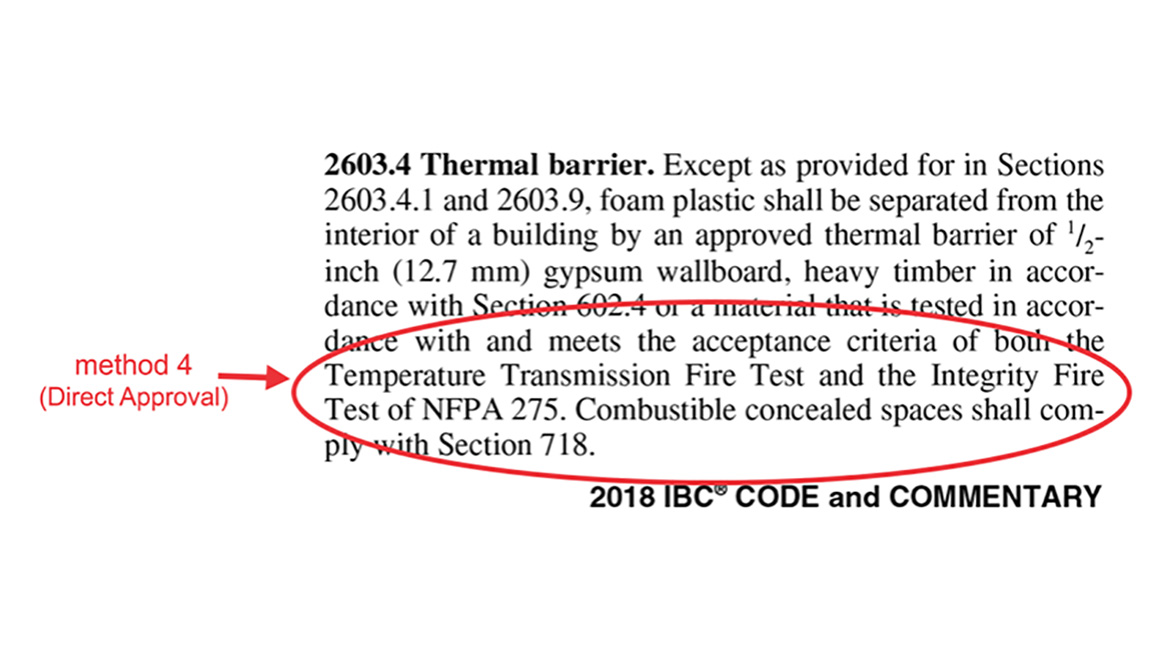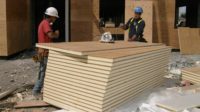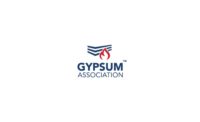Over the last several decades, more and more plastic has been used in the building industry, and with more plastics in buildings, the International Building Code has had to update its requirements for the flammability of those plastics.
It is at the point of the proliferation of plastics and composites that the thermal barrier section of the IBC code (and chapter 26 in general) came into useable existence. However, “thermal barrier” is a confusing term for the fire rating of a building element. It can easily be confused with terms like “thermal insulation” or “thermal bridging”—terms that relate to the transference of heat or cold through a material. Nevertheless, thermal barrier, as defined by the IBC, is very specific to heat and fire as it relates to safety.
The Underwriters Laboratories describes thermal barriers as such: “A thermal barrier is a material or product that prevents or delays the ignition of a flammable surface, such as foam plastic insulation or metal composite material, in the event of a fire.”
The World of IBC Chapter 26 and Thermal Barriers
According to the code, all plastics installed in the building envelope require an additional thermal barrier. IBC Section 2603.4 defines thermal barrier and four various deviations, derivatives or direct compliance approaches to allow the safe application of plastics.
Figure 1 illustrates three of the four methods.

There’s also a fourth “equivalent compliance” method that identifies a multi-test test protocol (NFPA 275) for achieving an equivalent rating to gypsum (Figure 2). Any product that strives to be equivalent to 1/2-inch gypsum must meet this protocol.

If an insulation material that meets NFPA-275 standards can also serve as a thermal barrier, then post-added thermal barriers (for specific use and requiring multiple steps) can be eliminated.
Solutions of the Past: “Add-on” Products over Plastics
Historically, spray polyurethane foam met code by being applied behind gypsum (method one) or covered with approved, add-on thermal barriers, i.e., cellulosic and cementitious materials. SPF could also comply with the code through “exception” methods using lower-level ignition barrier approval (method two) or special approval testing (method three).
When choosing one of these methods, the questions are:
Which test(s) should be used?
Which combination of coatings, cellulose or cementitious materials should be used?
Over which foams?
At which thickness?
In which densities?
Addressing all combinations of SPF/coating/cellulose/cementitious solutions and the appropriate paperwork required by building officials is a separate topic in and of itself.
Monolithic Fire Performance
Current post-applied “exception-based” thermal barrier solutions become daunting when trying to ensure correct, safe application; they need to be properly applied, require third-party inspection and are utilized only in “conditioned spaces.” In addition, as soon as the thermal barrier is breached, the fire protection of the flammable substrate is lost.
NFPA-275 SPF products achieve fire performance monolithically. The foam fire barrier is built into the composite and is protective throughout the complete volume of the insulation – against fires from the outside in and inside out.
Even with thermal barrier technologies in NFPA 275 foam, the benefits of continuous insulation, air and moisture barrier, mold defense, structural rigidity and high-insulation value are maintained. Monolithic fire protection means safer solutions, fewer added steps and materials, and less cost and risk vs. a post-applied thermal barrier coating, cellulose, etc.
Reducing the Risk Window
NFPA-275 foam becomes an effective fire barrier as soon as the chemical reaction finishes. What benefit does this provide? Fire safety is “built-in” as soon as the foam reaction is complete, providing a “zero-risk window” and is very different from traditional methods, where flammable plastic insulation materials, both panels and continuous, require an additional thermal barrier post-installation. That gap in time waiting for the post-applied thermal barrier poses a life safety risk and liability.
Paradigm Shift—SPF Enters the Fireproofing Realm
An often-overlooked paradigm shift credited to monolithic NFPA-275 SPFs is the ability to increase rated fire resistance. Historically, only non-combustible building elements like brick, stucco and concrete have achieved this. By passing ASTM E119 (method four), SPF reduces temperature transmission through walls and ceilings. As the thickness of the monolithic fire barrier SPF increases, so does its ability to delay the transmission of heat and poisonous fumes, increasing the overall wall system’s hour rating, just like gypsum.
This extends the thermal barrier SPF into the realm of fireproofing—something previously unavailable—and opens many new and creative avenues.
Embracing the Benefits
At the end of the day, architects, builders, contractors and even end-users care about better value. NFPA-275 thermal barrier high R-value insulation liquids cost slightly more initially. However, the total costs, including speed of installation, overall quality and end-user impact generate significant value across the complete construction hierarchy, resulting in significant cost savings, with costs decreasing as market penetration increases.
These new technologies are improving total costs and margins in major areas of construction, such as commercial, government, union and prevailing wage projects. These benefits translate into other large fringe areas, such as agriculture, commercial cold-storage facilities, grow houses, outbuildings, and military and aviation hangars.
The elimination of steps translates into lower costs, more efficient installations and, most importantly, a lower risk for the loss of life and property—a true trifecta of value.
As always, remember what’s really at stake—it’s not just a code issue, it is a life safety issue.








Report Abusive Comment